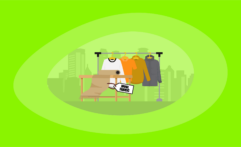How Sustainable Is Thuya Wood? Here Are the Facts
Impactful Ninja is reader-supported. When you buy through links on our site, we may earn an affiliate commission.
Learn more
Learn more
.
Hey fellow impactful ninja ? You may have noticed that Impactful Ninja is all about providing helpful information to make a positive impact on the world and society. And that we love to link back to where we found all the information for each of our posts. Most of these links are informational-based for you to check out their primary sources with one click. But some of these links are so-called "affiliate links" to products that we recommend. First and foremost, because we believe that they add value to you. For example, when we wrote a post about the environmental impact of long showers, we came across an EPA recommendation to use WaterSense showerheads. So we linked to where you can find them. Or, for many of our posts, we also link to our favorite books on that topic so that you can get a much more holistic overview than one single blog post could provide. And when there is an affiliate program for these products, we sign up for it. For example, as Amazon Associates, we earn from qualifying purchases. First, and most importantly, we still only recommend products that we believe add value for you. When you buy something through one of our affiliate links, we may earn a small commission - but at no additional costs to you. And when you buy something through a link that is not an affiliate link, we won’t receive any commission but we’ll still be happy to have helped you. When we find products that we believe add value to you and the seller has an affiliate program, we sign up for it. When you buy something through one of our affiliate links, we may earn a small commission (at no extra costs to you). And at this point in time, all money is reinvested in sharing the most helpful content with you. This includes all operating costs for running this site and the content creation itself. You may have noticed by the way Impactful Ninja is operated that money is not the driving factor behind it. It is a passion project of mine and I love to share helpful information with you to make a positive impact on the world and society. However, it's a project in that I invest a lot of time and also quite some money. Eventually, my dream is to one day turn this passion project into my full-time job and provide even more helpful information. But that's still a long time to go. Stay impactful,Affiliate Disclosure
Why do we add these product links?
What do these affiliate links mean for you?
What do these affiliate links mean for us?
What does this mean for me personally?
![]()
Thuya trees tend to develop a burl underground at the base of the trunk. Such burl wood is strong, smooth, fragrant, and very beautiful. It is often considered similar to burl wood from a redwood tree and highly-priced in decorative woodwork. However, thuya trees are rare as they grow primarily around the Atlas mountain region. Digging out the burl also kills a thuya tree. So we had to ask: How sustainable is it to buy products made of thuya wood?
Thanks to carbon sequestration and carbon offset, thuya wood could be a sustainable material. However, the harvesting of underground burls is unsustainable. It kills trees while releasing CO2. Long transporting distances also mean a high carbon footprint, more than that of timber from US forests.
In this article, we’ll walk you through the life-cycle of thuya wood used as veneer or for household items like decorative boxes. Then, we evaluate its sustainability, potentials, and shortfalls. And in the end, we’ll show you tips for buying sustainable thuya wood.
Here’s How Sustainable Thuya Wood Is
Thuya wood comes from an evergreen softwood tree species. Timber from a thuya tree’s burl is famed for its aroma, deep color and swirl-like grain. It is perfect for unique handicraft projects.
However, the population of this tree species is small, as the trees are rare and under much exploitation. That makes thuya wood timber rather unsustainable. Still, it is important to note that wood is better for the environment than plastic, especially when sourced from sustainably managed forests.
“Sustainable: The ability to be maintained at a certain rate or level | Avoidance of the depletion of natural resources in order to maintain an ecological balance”
Oxford Dictionary
To understand the sustainability of thuya wood, we assess the life-cycle of thuya wood in household items like a box or an earring. This life-cycle assessment (LCA) is a method to evaluate the environmental impacts of each stage in a product’s life-cycle, from the making to the recycling. Over the years, companies have strategically used LCA to research and create more sustainable products.
In this article, we’ll use the cradle-to-grave perspective of the LCA, examining the five stages of the life cycle of thuya wood.
| The life-cycle stages of thuya wood | Each state’s sustainability |
| Growing of thuya wood | Growing thuya trees in their native woodlands is sustainable because of carbon sequestration and carbon storage in the tree and its rooting system. The trees also provide more than just timber. However, the uncontrolled digging of tree burls for decorative woodwork damages the forests and affects the sustainability of this timber. |
| Manufacturing of thuya wood | Using thuya wood in decorative projects can have a relatively low carbon footprint when wood waste is utilized to make by-products or biomass pellets to offset the carbon emissions during harvesting and processing. Significant reduction in carbon emissions can also come from using fossil-free energy. |
| Transporting of thuya wood | Transporting is a carbon-intensive stage in the life cycle of thuya wood furniture due to the emissions associated with operating the hauling vehicles that take timber to sawmills and factories, then furniture to stores. As thuya wood in the US would come from North Africa or Southern Europe, transporting thuya wood products has a higher carbon footprint than products made with regionally available wood. |
| Usage of thuya wood | Using thuya wood items can be sustainable thanks to the carbon capture during the product life. |
| End-of-life of thuya wood | The end-of-life stage for thuya wood furniture is sustainable when the wood is reused or burned as bioenergy. |
We’ll say that it is very difficult to source sustainable thuya burl wood. Yet, the actual environmental impact of a particular product depends on many factors, especially the distance and mode of transportation. Let’s dive deeper into each stage and find out how it can be more sustainable.
How Sustainable Is the Growing of Thuya Wood
Growing thuya trees in their native woodlands is sustainable because of carbon sequestration and carbon storage in the tree and its rooting system. The trees also provide more than just timber. However, the uncontrolled digging of tree burls for decorative woodwork damages the forests and affects the sustainability of this timber.
What Type of Wood is Thuya Wood and What Does This Mean for Sustainability
Thuya trees belong to a small, evergreen, coniferous genus in the cypress family, Cupressaceae. This genus contains only one species, Tetraclinis articulata. Common names for these softwood trees include Sandarac Gum, Mediterranean Alerce, Arar, Berber thuya, and thuya d’Algérie. The trees are also sometimes referred to as Barbary Thuja. However, they are not to be confused with thuja species which are native to North America and Asia.
Thuya trees grow slowly. It typically takes 70 years for these trees to mature and be ready for timber harvest.
What makes Tetraclinis articulata trees special is that it is coppice. It means they can regrow from the stump after events like wildlife or animal grazing. Only a very small number of conifers have this ability, which is desirable in forestation.
How Sustainably Does Thuya Wood Grow
Living thuya trees can mitigate global warming impact through carbon sequestration. However, digging out thuya burl roots is an unsustainable way of harvesting timber. Such practice exacerbates the declining population of this rare tree species. Thus, using thuya wood is worse for the environment than using softwood from sustainably managed temperate forests, such as FSC-certified Douglas fir or pine.
- Declining population: Thuya trees are a rare species, growing solely in the Atlas mountain region in Northern Africa with the exception of small distributions in Malta and southern Spain. Due to several threats, this small population of thuya trees has been declining for decades.
In Africa, thuya trees, alongside cedar and oak trees, once covered a large part of the Atlas Mountains. However, excessive and uncontrolled land clearing and overcutting reduced the population of thuya trees to a very small number.
Wildfire is another threat to thuya trees. For example, a 2011 forest fire affected 59% of the thuya population in Spain’s Murcia region.
Thuya trees are coppiced, which means they can regrow from stump. However, natural recovery is low partly due to the competition from Aleppo pine. Also, animal grazing can kill the coppice regrowth before it gets tall enough (to be out of the reach of livestock).
- Unsustainable harvesting practice: Though damaging, cutting down thuya trees and burning the forest to clear the land encourages the formation of burls with deep colors, beautiful swirls, and wonderful aroma. Burl wood is also amazingly hard and polishes up like glass.
Because burl wood is considered superior to the bland-looking trunk wood, burls are much more popular and often dug up for decorative wood projects. This means two things. Firstly, no more regrowth (and population recovering). Secondly, a higher carbon footprint as digging up the root releases all the carbon dioxide that has been captured by the tree and stored in the rooting system.
However, when thuya wood trees are harvested in a sustainable way, the carbon sequestration and carbon storage in tree trunks and roots (as well as in timber and wood products) contribute to its being more sustainable than materials like wood plastic composite. Besides, thuya trees provide more than just timber, increasing the benefits of forestry land use.
- Carbon sequestration: As thuya trees grow, they absorb CO2 from the atmosphere while releasing oxygen. They act as a carbon sink during their lifespan. This means that they are taking greenhouse gasses out of the atmosphere, helping to mitigate the climate crisis. Carbon is stored in the root system and in the tree, which can reach 50 feet in height and 2 feet in trunk diameter. Thuya trees have carbon biomass of 3.31kg.
- Land use: Thuya forests can be managed sustainably to harvest several useful products.
Resin or gum sandarac is used in the manufacturing of varnish. Dissolving gum sandarac in turpentine is known to make the best varnish. Thuya resin is also used in powder form to clean vellum, preparing it for writing purposes. A pine-scented oil can be extracted from the resin and used in aromatherapy and homeopathy.
Oil or tar produced from old wood can be used to treat livestock wounds. Local people also use leaves and cones to treat various health problems.
Wood from the trunk and branches is commonly used as heating fuel while wood from underground burl is highly valued in decorative woodwork.
Thuya trees are also used in afforestation in arid regions, where few species are able to grow. Because of its coppice nature and its ability to adapt to severely eroded soils, this tree species is suitable for reclaiming forests while providing valuable forestry products.
Where Is Thuya wood Wood Usually Grown
Thuya trees grow natively in North Africa and Southern Europe. The primary range of thuya (Tetraclinis articulata) species is the Atlas Mountains of Morocco, Algeria, and Tunisia. Small, outlying populations are found in Malta and southeastern Spain.
Harvesting thuya wood from natural forests can result in biodiversity loss regarding the tree species and wild animals that feed and shelter in the forests.
One example is when loggers only cut down the biggest and tallest trees. That pattern would cause a reduction in the genetic diversity and quality of the trees within the stand, leading to gradual degradation of tree quality.
Cutting down thuya trees also disrupts the forests’ wild animals, which depend on the forest for food and shelter. For example, the caracal is an animal that lives exclusively in Morocco’s argan and thuya woodlands. Their existence is tied with the growth or destruction of thuya trees.
Together with pine and oak, thuya trees make up one of the five major forest types in North Africa. This tree species has a significant role in the ecoregion, supporting many large and small mammal species. The region also hosts an outstanding bird community of more than 120 species, including endemic subspecies like the spotted woodpecker or endangered species like the golden eagle, black-shouldered kite, short-toed eagle, or booted eagle.
Unsustainable practices are common in harvesting thuya wood, especially in countries like Morocco, where local foresters focus on the high-priced burl wood.
The only way for consumers to tackle problems caused by illegal logging is to source sustainable woods. We will point you in the right direction with thuya wood at the end of this article.
In total, logging of forestry products from plantations accounts for 26% of forest loss, a combination of deforestation and forest degradation. However, in tropical climates, the loss in bio-diverse forests is more significant (and sometimes less properly recorded) than that in temperate, well-managed logging forests.

How Sustainable Is the Manufacturing of Thuya Wood
Using thuya wood in decorative projects can have a relatively low carbon footprint when wood waste is utilized to make by-products or biomass pellets to offset the carbon emissions during harvesting and processing. Significant reduction in carbon emissions can also come from using fossil-free energy.
The first step of manufacturing thuya wood furniture involves cutting down trees and/or digging up the root and turning them into lumber in a sawmill. Sawing is an electricity-consuming step.
The next step is to dry lumber and turn it into household items. If a piece of lumber can be air-dried to the desired moisture content, no added energy is needed for this step. However, if a kiln is used, it requires extra energy, which could mean higher carbon emissions.
As thuya wood is difficult to dry, a kiln is often used. When fossil fuel is used to operate a kiln, it adds to the total carbon emissions. However, burning wood waste (biomass) generates energy to replace fossil fuels. Luckily, at least 90% of all thermal energy used for kiln drying in the US hardwood sector comes from biomass (instead of fossil fuels).
Kiln-drying can also be fuelled with other types of non-fossil energy, such as solar power or hydropower, resulting in a smaller carbon footprint. In a study experimenting with a solar wood dryer with glazed walls, 27 mm thick boards of thuya wood take 366 hours to reduce the moisture content from 35% to 15%.
How Sustainable Is the Transportation of Thuya Wood
Transporting is a carbon-intensive stage in the life cycle of thuya wood products due to the emissions associated with operating the hauling vehicles that take timber to sawmills and factories, then furniture to stores.
As thuya wood in the US would come from North Africa or Southern Europe, transporting thuya wood products has a higher carbon footprint than products made with regionally available wood, like pine or oak.
The actual emission during the transporting stage depends on the type of vehicles used, the fuel they need, and the distance the wood travels. Calculations made by the Norwegian Forest and Landscape Institute showed that smaller wood hauling trucks emitted more CO2 per transported cubic meters of timber: 1.25 times more than larger wood hauling trucks, 1.3 times more than sea vessels, and six times more than freight trains. Therefore, the sustainable transportation option would be rail or large trucks running on biofuel. You can check with your wood suppliers how their products are transported to and within the US and opt for the more sustainable option.
How Sustainable Is the Usage of Thuya Wood
Using thuya wood items can be sustainable thanks to the carbon capture during the product life.
Thuya wood is considered durable with high resistance to insect attacks. It means that items made with thuya wood, especially the harder burl wood, can last for many years under normal usage.
When thuya wood is decayed, either naturally in the forest or because of damage caused by usage at home, the carbon stored in the wood is released back to the atmosphere. Therefore, long-lasting furniture can be considered a good way of keeping carbon out of the atmosphere. If the wood is then reclaimed for making another piece of furniture, its positive carbon storage environmental impact is even higher.
How Sustainable Is the End-of-Life of Thuya Wood
The end-of-life stage for thuya wood furniture is sustainable when the wood is reused or burned as bioenergy.
There are a few scenarios for wood products – veneer or decorative boxes – at the end of their life:
- They can end up in landfills and don’t decompose. In this case, it keeps its role as carbon storage.
- Wood products can also be upcycled and reused, extending their role as carbon storage and reducing the fossil CO2 emitted as much as four times when comparing, for example, a recovered hardwood flooring with a new one. New wood products often travel much further to their markets, compared with recovered wood products. The latter is typically made in urban centers and sold locally, which lowers the transportation environmental burdens.
- In another end-of-life scenario, products like a thuya wood box can be burned for biomass energy displacing coal or natural gas in generating electricity.
With smaller items, the offset won’t be as high as there is much less waste for burning. However, if such products are made from wood waste as by-products, their carbon footprint is minimal.
How Can You Buy Thuya Wood More Sustainably
The key to sustainably buying any wood is to check on relevant environmental and original certifications. Reliable certifications for sustainable woods are:
An FSC certification ensures that the thuya wood comes from responsibly managed forests that provide environmental, social, and economic benefits.
PEFC’s approaches to sustainable forest management are in line with protecting the forests globally and locally and making the certificate work for everyone. Getting a PEFC certification is strict enough to ensure the sustainable management of a forest is socially just, ecologically sound, and economically viable but attainable not only by big but small forest owners.
However, FSC and PEFC certifications are not available for thuya wood. Consequently, it is much harder to trace the sustainable practices applied for a certain item made with thuya wood. Equally important to note is that thuya (Tetraclinis articulata) tree species is on the IUCN’s Red List of plants. Their population in Morocco is vulnerable.
Why Is It Important to Buy More Sustainable Wood
Buying sustainable wood also means helping to prevent illegal or unsustainable logging, which harms the forests’ biosystems and accelerates climate change.
Logging of forestry products from plantations accounts for 26% of forest loss. Cutting down trees for wood has a lesser impact on carbon storage than digging up the whole forest floor and turning it into farms or mines. However, if logging is not sustainably managed, it can badly damage wildlife.
When logging happens in tropical forests – the bio hotspots of our planet – the biodiversity loss can be much more damaging. Subtropical and tropical forests are packed with unique wildlife – endemic mammals, birds, and amphibians. The displacement of such wildlife during poorly managed logging would be a major contributor to global biodiversity loss.
Sustainable management of forests also means that trees are cut down for timber only when they are mature. These trees will then be able to regrow and eventually replace the loss of canopy, absorb carbon from the atmosphere and reduce the effect of climate change.

Final Thoughts
You might be able to find items made from thuya wood that is sustainably harvested. However, the rapidly declining population of thuya trees and the long traveling distance raise concerns over the sustainability of using thuya wood, especially from the trees’ underground burls. If you do decide to buy an item made with thuya burl wood, make sure you use it for as long as you can, upcycle the material to extend its usage, and arrange for it to be recycled fully.
Stay impactful,

Sources
- Global Wood Source: What is burl wood?
- Reuters: Ditch metal and plastic and turn to wood to save the planet, says U.N.
- Science Direct: Life-cycle assessment (LCA)
- MIT SMR: Strategic Sustainability Uses of Life-Cycle Analysis
- European Environment Agency: cradle-to-grave
- AMERICAN CONIFER SOCIETY: Tetraclinis Genus (Arartree / Sandarac gum tree)
- AMERICAN CONIFER SOCIETY: Thuja Genus (arborvitae)
- THE FAIR TRADE STORE: What is Thuya Wood? 9 Facts to Help Explain…
- THE WOOD DATABASE: THUYA
- Impactful Ninja: How Sustainable Is Douglas Fir Wood? Here Are the Fact
- Impactful Ninja: How Sustainable Is Pine Wood? Here Are the Facts
- Gilmer Wood Company: THUYA BURL
- EUROPEAN COMMISSION LIFE PUBLIC DATABASE: CONSERVATION OF HABITAT “9570 * Tetraclinis articulata FOREST” IN THE EUROPEAN CONTINENT
- Hobbithouseinc.com: THUYA
- OKLAHOMA STATE UNIVERSITY: What is Wood Plastic Composite
- EOL: Arar Tree
- UICNMED: Tetraclinis articulata (Vahl.) Masters.
- iForest: Developing a stand-based growth and yield model for Thuya (Tetraclinis articulata (Vahl) Mast) in Tunisia
- WWF: ::: Project report :::Morocco’s argan and thuya woodlands
- World Wildlife: Northern Africa: Morocco, Algeria, and Tunisia
- Our World in Data: Deforestation and Forest Loss
- American Hardwood: Environmental Life Cycle Assessment
- Research Gate: Modelling of a solar wood dryer with glazed walls
- Impactful Ninja: How Sustainable Is White Oak Wood? Here Are the Facts
- Science Norway: Larger logging trucks give less CO2 emissions
- Research Gate: Life cycle primary energy and carbon analysis of recovering softwood framing lumber and hardwood flooring for use
- Impactful Ninja: What Is the Carbon Footprint of Biomass Energy? A Life-Cycle Assessment
- FSC: FSC Statement on Myanmar’s Escalating Crisis
- Program for Endorsement of Forest Certification
- IUCN: THE IUCN RED LIST OF THREATENED SPECIES
- Our World in Data: Epidemic Mammal Species




